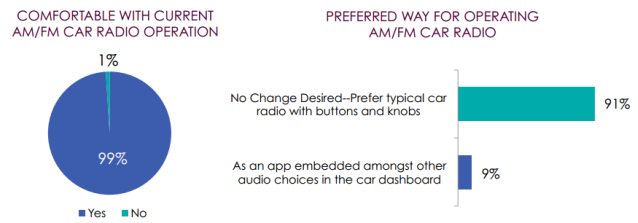Technology disruption cycles exhibit a push-pull of consumer resistance and adoption. Change always encounters resistance from the mainstream market which is entrenched in the familiar. At the same time, early adopters on the fringe enable innovation and encourage change. Gradually, the fringe seeps inward toward the center. Eventually (usually in a longer time than predicted by enthusiasts), the new thing becomes the standard thing.
It is in that tug-of-war framework that one might view the newly released Ipsos In-Car Audio Study. The survey of 1,000+ Americans seeks to identify preferences of in-car listening choices among terrestrial radio, CDs, MP3 players, SiriusXM, Internet streaming, and HD Radio. The research was commissioned by iHeartRadio.
Survey Results
Three key results are making the news today. First, survey respondents listen to their car radio more than other audio sources. Second, most people (80%) would select AM/FM radio to be in their next car. Third, nearly all respondents (99%) expressed “comfort” with traditional button/knob radio operation, a most of them (91% of the total sample) wanted button/knob radio operation to remain in future dashboards. Only nine percent would prefer terrestrial radio to be presented as a dashboard app among other audio choices.
“No Change Desired” — that is Ipsos’ result language, and a polar clarion call in the push/pull of technology change.
One fact about cars puts important context around the Ipsos study: The average American car is 11.4 years old, according to IHS automotive’s annual study (June, 2014 edition). That figure represents record longevity, as American cars have gotten older over recent years.
Eleven and a half years ago (fall, 2003), the iPhone was two years away. Spotify’s U.S. launch was five years off. An aftermarket for plugging MP3 players into car dashboards was getting started. Button-and-dial radio was typically front-and-center of the head unit. Dashboards in most 2003 cars are unfriendly to streaming audio. To some extent, the Ipsos study might reflect consumers saying they like what they’re used to in the car. But beyond that, there is a disruption in progress that is more comprehensive than how the radio is positioned.
Digitization of Dashboards
The inevitable digitization of the car dashboard is not just about audio — maybe not primarily about audio. Dashboards, as they become digital platforms mimicking how smartphones organize our lives, must give drivers the familiar options of their non-car lives. The smartphone is how millions of people organize their lives, including their listening. Car dashboards must emulate the organizational capacity of phones during the large amount of time millions of people spend driving.
That capacity is created by making a horizontal platform, governed by an operating system that can do many things. Like a computer or smartphone, in other words.
The horizontal platform is a notoriously difficult conceptual adjustment when consumers shift from analog to digital. When computers were new, many people were confounded by the resemblance to TV, and would learn vertical computing functions (e.g. accessing an online bank account, receiving email) as discrete tasks rather than learning how to operate a computer generally. Looking at an online bank account is a vertical function in a horizontal platform. TV is also highly vertical, with a mild horizontal aspect of different channels. (Web-enabled TVs have become more horizontal and platform-like.)
Platform or App?
Is radio a platform or an app? AM/FM radio is a platform among other audio platforms. But “the radio” is different. Push-button radio is a dedicated hardware app for receiving a few geo-limited broadcast signals. As such, it is untenable in modern cars. Putting a push-button radio in a digitized dashboard would be like attaching an ink-and-paper typewriter to a computer because people liked typewriters when they were prevalent. The advantages of a horizontal digital platform, on which you can type, send, receive, publish, buy, sell, market, learn, teach, listen, broadcast, and much more, are overwhelming and world-changing.
Radio is increasingly personalized, interactive, and on-demand. Even for traditional stations, sophisticated mobile apps and the rise of podcasts can change how terrestrial brands are conceived, perceived, and received. That’s an opportunity for publishers, listeners, and marketers, and can happen in the car — but only on a digital dashboard platform.
The Future
In January, consulting firm Gartner predicted that a quarter-billion connected cars will be on the road in 2020. Auto industry analyst Roger Lanctot of Strategy Analytics thinks that car companies need to accelerate their emulation of smartphone benefits. “Auto makers are the new deer in the headlights of the smartphone industry,” Lanctot wrote in a recent column, comparing the threat to car makers with Kodak’s failure to recognize digital realities. “Car makers need to gain a better grasp of the power and intimacy inherent in connectivity. Wireless carriers and handset makers have embraced and been empowered by this new customer experience. Car makers must do likewise.”
What about adoption on the consumer side? In October, Nielsen reported survey results indicating that among newer-car buyers, use of streaming was high. In a sample of connected-car owners, 72% said they use streaming audio regularly; 36% every time in the vehicle.
An Ipsos survey in 2020 might yield different results. At that time, if car longevity remains steady, the average car will be five years more advanced in streaming friendliness. In the meantime, today’s owners of 11.4-year-old cars will be buying new ones with dashboard experiences that provide audio choices that people use outside the car. (Edison Research just announced that 53% of American adults listen to online radio at least monthly.)
Audio is more vibrant than ever. Slow replacement of expensive cars makes the in-car experience lag behind the rapid iterations of computers, phones, tablets, and connected-speakers. But cars are in the same disruptive and progressive wave of change.

